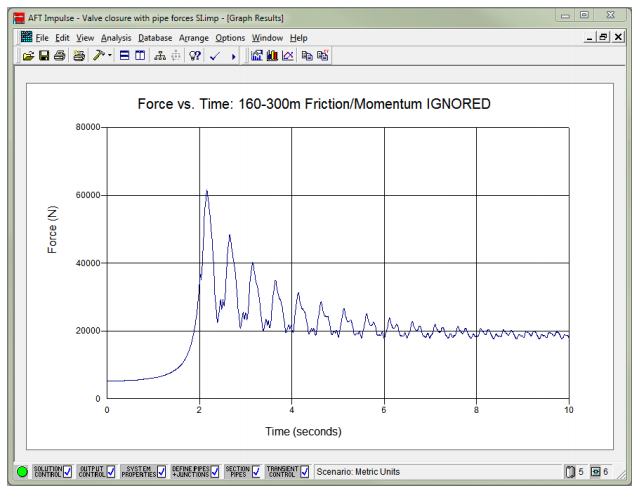#70366 - 11/13/17 08:29 AM
 Re: Waterhammer - cutoff frequency
[Re: RodrigoVicente]
Re: Waterhammer - cutoff frequency
[Re: RodrigoVicente]
|

Member
Registered: 01/29/10
Posts: 1025
Loc: Louisiana, US
|
Let's take it step by step, then. - Imagine a very long run of pipe with an expansion loop in the center.
- You have 5 elements of pipe, split by nodes 10, 20, 30, 40, 50 and 60.
- The flow of liquid was from 60 to 10 and the system is closed suddenly at 10 and 60.
- As the fluid momentum is attempted to suddenly halt, a fluid obeying Bernoulli's correlation P+1/2*rho*vē has to swap all kinetic energy into static energy, or pressure.
- As the fluid is nearly incompressible, the amount of energy that doesn't cause the pipe to expand locally is backed down the pipe at the speed of sound.
- When it does so, it is not unlike a rocket. Force 1 acts on element 10-20 axially, up until the pressure wave gets to the elbow. Direction of force at this point in time is opposite of what was the flow, because the high pressure side is coming from node 10.
- When it passes node 20, loads on 10-20 cease, but aren't reversed, and are now on nodes 20-30, again, opposite in direction of original flow. (In reality, the energy is split. Some portion will travel back to node 10, but the majority will go to node 30. For simplicity, we'll assume it all goes to node 30 for now.)
- The pressure wave continues through the system, self canceling, but not reversing, up until it gets to node 60. If the pipe had no elasticity to "bounce" back into place, then nodes 10 and 20 would still be deflected, because the forces were cancelled, but not reversed to push the pipe back into place.
- Now, repeat the above steps, except in reverse, as the pressure wave reflects back from node 60 to node 10. If the pipe had no elasticity to "bounce" back into place, then this pressure wave will put it back into place, minus the losses exhibited as the pressure wave travels down the line.
Observations: - Elements 10-20 and 50-60 will have loads switching on/off on them far less frequently than elements 20-30, 30-40, and 40-50.
- Elements between 20-50 will have loads switching on/off at a higher frequency, but frequency of turning on is a function of overall length.
- Worst case with back-refracted waves is if they are able to achieve resonance.
See attached graph from Aft-Impulse Documentation depicting this behavior. Original file located here: http://www.aft.com/documents/AFT-Evaluat...-02-2013-SI.pdfLooking at the far right end, you can get an idea of what kind of frequencies they get. I suggest adapting this for your model. 
Edited by Michael_Fletcher (11/13/17 08:31 AM)
Edit Reason: formatting
|
|
Top
|
|
|
|
|
|
0 registered (),
60
Guests and
2
Spiders online. |
|
Key:
Admin,
Global Mod,
Mod
|
|
|
|
|
|
1
|
2
|
3
|
4
|
|
5
|
6
|
7
|
8
|
9
|
10
|
11
|
|
12
|
13
|
14
|
15
|
16
|
17
|
18
|
|
19
|
20
|
21
|
22
|
23
|
24
|
25
|
|
26
|
27
|
28
|
29
|
30
|
31
|
|
|
12065 Members
14 Forums
16973 Topics
75151 Posts
Max Online: 303 @ 01/28/20 11:58 PM
|
|
|